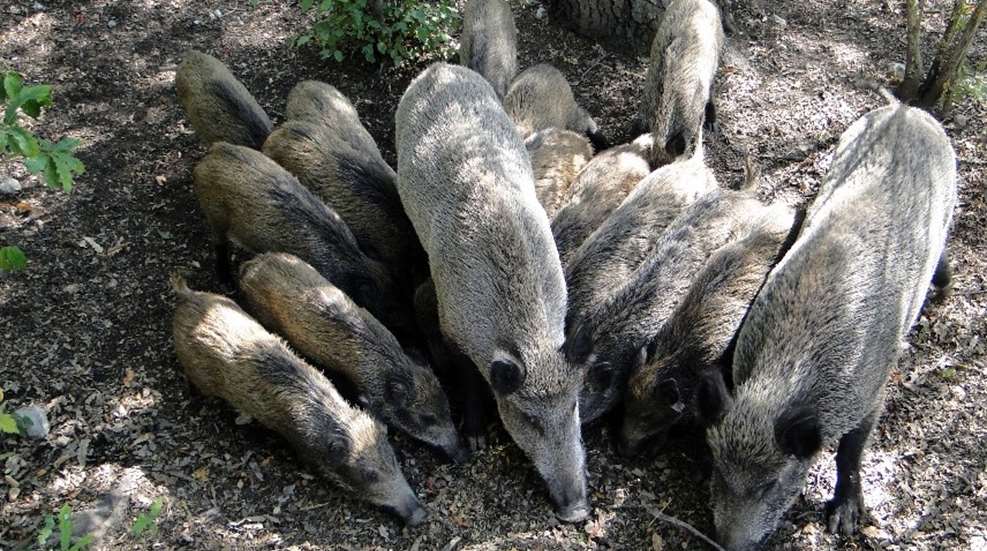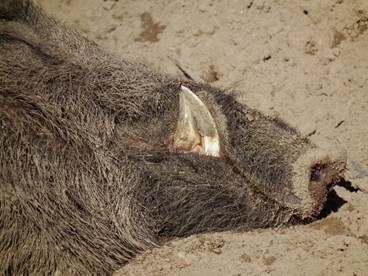
At least within the environmental and hunting communities, we’ve heard it. We know it’s an almost-plague that seems to have no end in sight. We know farms are being hit hard, habitats and territories are being torn to shreds, young livestock are being killed while older ones risk contracting a plethora of diseases and parasites. Our woods and fields are seeing more and more each day, sightings in communities and neighborhoods is on the rise and the price tag of damage is in the billions. Two words: Feral swine.
Beginnings
In the 1500s Spanish settlers brought over the first Eurasian wild boars to the New World. Christopher Columbus introduced them to the Caribbean and Hernando De Soto shuttled them over to Florida. These pigs were to be used as farm animals. Some settlers would keep them caged, but many would let them roam free until they were needed. During times of economic downturns or wars, families would abandon their homesteads, leaving behind their pigs to fend for themselves. By the 1930s, boars were being transported across the country for purposes of hunting. These actions, as well as others, caused the beginnings of the massive feral population of pigs in the U.S.
Today, through their ability to rapidly procreate, illegal movement by sports hunters and escapes from domestic farms, feral swine can now be found in 39 states and two Canadian provinces—and experts estimate their numbers to be well over five million. California, Florida, Oklahoma and Texas have the largest populations. In Texas, where there’s a population of about 2.6 million feral hogs, their reported the costs of swine-borne damages and maintenance for the state is $500 million a year.

The Physique and Breeding Capacity of Feral Swine
Feral swine (or wild hogs, feral hogs, wild boar) have curved “tusks”—which are teeth—that can reach seven inches in length and protrude out of the mouth from the bottom jaw. These tusks are appropriately called “cutters,” and are constantly being sharpened by teeth in the top jaw called “whetters” or “grinders.” The cutters are used for protection against an opponent, digging (wallowing), cutting through thick tree roots (rooting) and more.
They have a shield of cartilage and scar tissue that protects their shoulders and ribs. With every puncture, tear and rip the shield grows back even thicker than before. Due to this dense shield, it’s recommended to use a caliber like 30-06 since .44 magnums and .45/70’s have been known to not fully penetrate the hog’s armor of cartilage.
As mentioned above, a major reason why the feral pig population has abundantly soared is due to the fact that they are the most prolific large mammal on the face of the Earth, meaning they breed efficiently. A female pig can be sexually mature between six and eight months of age, although 13 months is the most common, and have 1.5 litters per year with each litter averaging five to six piglets. The average lifespan of a pig is between four and eight years. So, if a pig lives to be six years old and maybe doesn’t sexually mature until one year, she’s able to produce between 38 and 45 piglets in her life. Now let’s just say she had 40 piglets and half of those were females—20. Those 20 piglets could potentially produce 820 more piglets within six-year life spans. Another example of their breeding efficiency: If 70 percent of pigs in a region are killed, that population can return to their full strength within two or three years.
Environmental Tolls
As awful as their population numbers are, their destruction to farmlands, environments and communities is odious. It’s estimated that feral swine in the United States cause more than $1.5 billion in damages and control costs each year. They damage natural resources by rooting and wallowing, which causes erosion to river and stream banks. They compete with native wildlife for food—although with the massive pig population it’s hardly a fair competition—and prey on turtles, turtle eggs and ground-nesting birds.
The habits and activities of feral pigs have a huge impact on agricultural resources as well. The rooting and wallowing mentioned above increases the erosion around trees, damaging fruit and nut trees as well as trees raised for timber. A farmer’s crops are at risk of being trampled and eaten by a wave of hogs. Livestock, as well as house pets, are at risk for contracting any one of the numerous diseases carried by feral swine through their droppings, urine or shared water supplies. Pseudorabies, swine brucellosis, bovine tuberculosis, foot and mouth disease and numerous parasites all call the pig home.
Public Health is at Risk
The numerous diseases that are carried by feral swine are not just a threat to livestock but also people, and with their massive population human-pig interactions are increasing. How are the diseases a threat to us? Well, some of the diseases they carry are “zoonotic,” a disease that can be passed between animals and humans. Through contact of the pig’s bodily fluids, handling or ingestion of infected tissues, people are at risk of contracting leptospirosis, brucellosis, E. coli, salmonellosis, toxoplasmosis, rabies and more.
If you’re looking for a real world example: The 2006 spinach-linked E. coli outbreak is believed to have been caused by a list of culprits, one of them being feral swine. Their presence was found around the field that grew the contaminated spinach and they are known carriers of the disease. This outbreak caused more than 200 people to become ill and at least 30 others to develop hemolytic uremic syndrome, a possibly fatal kidney condition associated with an E. coli infection.
National Response to Feral Swine
A $20 million USDA initiative to get the feral swine population under control was put into effect in April 2014. The effort aims to help states deal with the rapidly expanding populations of hogs, starting with the states that have fewer numbers. The funding can be broken down into state-specific projects: establishing procedures for disease monitoring, including the development of new surveillance and vaccination methods; conducting research and economic analyses to improve control practices; and centralization of control operations and how to make them safer and more cost-effective.
The USDA initiative group will also work with Canada and Mexico on feral swine-damage management.
“Feral swine are one of the most destructive invaders a state can have. They have expanded their range from 17 to 39 states in the last 30 years and cause damage to crops, kill young livestock, destroy property, harm natural resources, and carry diseases that threaten other animals as well as people and water supplies,” said Undersecretary for USDA’s Marketing and Regulatory Programs Edward Avalos. “…we aim to eliminate feral swine from two states every three to five years and stabilize feral swine damage in 10.”
The Hunter’s Role
It’s pretty simple: hunt. Although the USDA is taking a strong initiative, hunters can help manage the feral pig population. Set up a hunt in one of the many states they are found in, especially if it’s your home state, or ask a local farmer if they have a hog problem and can you be of any assistance. While on a hunt or in the woods, be sure to report any unusual signs of hogs to your state’s wildlife division, mainly if you’ve never seen a hog in that area before.
Once you’ve done your part and taken out a hog, please follow these instructions to keep you and those around you safe:
- Wear gloves while touching or field-dressing the wild pig. Be exceptionally cautious when processing the meat.
- Use eye and mouth protection when butchering.
- Wash hands thoroughly after handling a pig, even if gloves are worn.
- Thoroughly clean and disinfect work areas and tools used to butcher the wild pig.
- Dispose of all animal remains, gloves, deeply-drenched clothing and materials. Check with your local health or state wildlife department on appropriate disposal methods.
- Follow correct refrigeration, freezing and cooking methods. Freezing to 0°F will render bacteria inactive, but will not destroy them; once thawed, bacteria can again become active. Also, do not rely on home freezing to destroy Trichina and other parasites. Thorough cooking will destroy all parasites and kill bacteria. Cook wild pork to an internal temperature of 165°F to 170°F.
For more information on feral swine please visit the USDA Animal and Plant Health Inspection Service and wildpiginfo.com





































